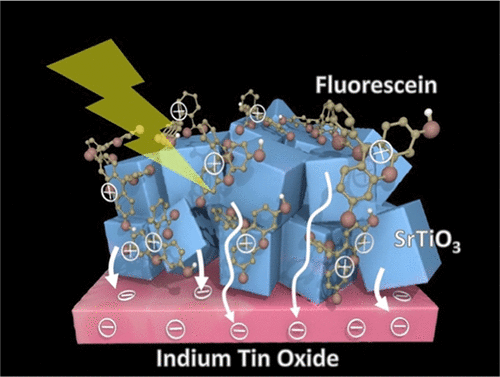当前位置:
X-MOL 学术
›
J. Phys. Chem. C
›
论文详情
Our official English website, www.x-mol.net, welcomes your
feedback! (Note: you will need to create a separate account there.)
Photochemical Charge Separation and Dye Self-Oxidation Control Performance of Fluorescein, Rose Bengal, and Triphenylamine Dye-Sensitized Solar Cells
The Journal of Physical Chemistry C ( IF 3.3 ) Pub Date : 2020-11-17 , DOI: 10.1021/acs.jpcc.0c09052 Ruirui Han 1 , Tea-Yon Kim 2 , Thomas W. Hamann 2 , Frank E. Osterloh 1
The Journal of Physical Chemistry C ( IF 3.3 ) Pub Date : 2020-11-17 , DOI: 10.1021/acs.jpcc.0c09052 Ruirui Han 1 , Tea-Yon Kim 2 , Thomas W. Hamann 2 , Frank E. Osterloh 1
Affiliation

|
The charge transfer kinetics between the dye, metal oxide film, and the transparent conductive oxide substrate are key to the optimization of dye-sensitized solar cells (DSSC). Here, we use surface photovoltage spectroscopy (SPS) to analyze photochemical charge separation and transfer in DSSCs made from D35, fluorescein, or Rose Bengal organic dyes, using either titanium dioxide or strontium titanate as electron transfer layers (ETL) and fluorine-doped tin oxide (FTO) or indium-doped tin oxide (ITO) as transparent conductive substrates. DSSC efficiencies range from 4.612% for D35/TiO2/FTO to 0.0003% for fluorescein/SrTiO3/ITO and are generally higher for the TiO2- and FTO-based devices. According to SPS, electron transfer from the dye into the SrTiO3 ETL is less reversible and accompanied by self-oxidation of the dyes. Electron transfer to FTO is more efficient than to ITO, which is attributed to the improved conductivity of the FTO/ETL configuration resulting from a higher annealing temperature and also to the higher work function of FTO. For FTO/TiO2-based devices, power conversion efficiencies correlate well with the surface photovoltage data. Overall, these results show that both efficiency and reversibility of electron transfer at the conductive substrate–ETL–dye interface are essential for DSSC performance. Additionally, we demonstrate that SPS can identify efficient dye/ETL combinations for application in improved DSSC and detect unstable dyes.
中文翻译:

荧光素,玫瑰红和三苯胺染料敏化太阳能电池的光化学电荷分离和染料自氧化控制性能
染料,金属氧化物膜和透明导电氧化物基板之间的电荷转移动力学是染料敏化太阳能电池(DSSC)优化的关键。在这里,我们使用表面光电压光谱(SPS)分析由D35,荧光素或Rose Bengal有机染料制成的DSSC中的光化学电荷分离和转移,使用二氧化钛或钛酸锶作为电子转移层(ETL)和掺氟锡氧化物(FTO)或铟掺杂的氧化锡(ITO)作为透明导电基板。DSSC效率从D35 / TiO 2 / FTO的4.612%到荧光素/ SrTiO 3 / ITO的0.0003%不等,并且对于TiO 2和FTO基器件通常更高。根据SPS,电子从染料转移到SrTiO中3 ETL的可逆性较低,并伴随着染料的自氧化。电子转移到FTO的效率要比ITO高,这归因于较高的退火温度导致FTO / ETL结构的导电性提高,也归因于FTO的功函数较高。对于基于FTO / TiO 2的器件,功率转换效率与表面光电压数据密切相关。总体而言,这些结果表明,在导电基材-ETL-染料界面处电子转移的效率和可逆性对于DSSC性能至关重要。此外,我们证明SPS可以识别有效的染料/ ETL组合,以用于改进的DSSC中并检测不稳定的染料。
更新日期:2020-12-03
中文翻译:

荧光素,玫瑰红和三苯胺染料敏化太阳能电池的光化学电荷分离和染料自氧化控制性能
染料,金属氧化物膜和透明导电氧化物基板之间的电荷转移动力学是染料敏化太阳能电池(DSSC)优化的关键。在这里,我们使用表面光电压光谱(SPS)分析由D35,荧光素或Rose Bengal有机染料制成的DSSC中的光化学电荷分离和转移,使用二氧化钛或钛酸锶作为电子转移层(ETL)和掺氟锡氧化物(FTO)或铟掺杂的氧化锡(ITO)作为透明导电基板。DSSC效率从D35 / TiO 2 / FTO的4.612%到荧光素/ SrTiO 3 / ITO的0.0003%不等,并且对于TiO 2和FTO基器件通常更高。根据SPS,电子从染料转移到SrTiO中3 ETL的可逆性较低,并伴随着染料的自氧化。电子转移到FTO的效率要比ITO高,这归因于较高的退火温度导致FTO / ETL结构的导电性提高,也归因于FTO的功函数较高。对于基于FTO / TiO 2的器件,功率转换效率与表面光电压数据密切相关。总体而言,这些结果表明,在导电基材-ETL-染料界面处电子转移的效率和可逆性对于DSSC性能至关重要。此外,我们证明SPS可以识别有效的染料/ ETL组合,以用于改进的DSSC中并检测不稳定的染料。











































 京公网安备 11010802027423号
京公网安备 11010802027423号